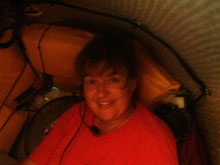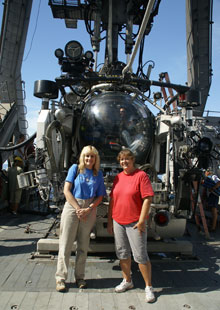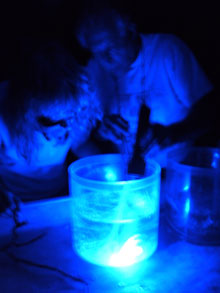
Educator-at-sea Angela Lewis in the aft compartment of the Johnson Sea-Link II submersible during her first dive experience. Click image for larger view and image credit.
The Wonder of Deep Ocean Exploration
July 25, 2009
Angela Lewis
Educator-at-sea
Harbor Branch Oceanographic Institution
Marine Oceanographic Academy
![]() Rare footage of a sea cucumber swimming in the deep sea.
Rare footage of a sea cucumber swimming in the deep sea.
I had been teaching chemistry and physics in Indiana, and about two years ago I read an article Dr. Edith Widder had published about bioluminescence that made me begin to wonder. This article led me to find out more about Harbor Branch Oceanographic Institution (HBOI), where Dr. Widder was working, which in turn led me to a new adventure: an opportunity to teach at a high school located at HBOI, the Marine Oceanographic Academy. I knew this was a place that was filled with adventure and would lead me to opportunities to discover more about the ocean, which it did. Recently, HBOI scientist Tammy Frank invited me to go along as the educator-at-sea on the Bioluminescence 2009 expedition. Of course, my answer was, “When are we leaving?”
This opportunity generated questions in my mind. “I wonder what we will find? What does it feel like when you lose sight of the shore? What does the deep sea look like? How did they pick the spot to explore? What is it like to live on a ship?” This incredible opportunity has allowed me to share in new discoveries, meet new people, and experience things that I will be able to share with my students and family. One of the most memorable experiences has been the opportunity to descend to the deep ocean in the Johnson-Sea-Link II submersible.
The Johnson-Sea-Link allows scientists to explore areas where literally no man has gone before due to the physical constraints of pressure and darkness. In the submersible the atmospheric pressure is kept at 1 atmosphere, while the outside pressure at a depth of 671 meters (2,200 feet) is about 70 atmospheres! How much pressure is that? It is the same amount of pressure that would be applied by a stack of three commercial jets. I am still amazed that engineers are able to build a submersible that not only is able to withstand that kind of pressure but can also maneuver around, delicately collect marine organisms, and capture imagery from the deep sea. And how is it that the delicate creatures that make the deep sea their home can withstand that kind of pressure?
The Bioluminescence 2009 science team is made up of scientists who study different and specific disciplines in biology, ecology, and taxonomy. Being on an expedition with this team of scientists has bolstered my idea that students need to “wonder why” in order to be interested in what they are learning. While each scientist has certain questions that they are particularly exploring, I am sure that when they discover the answers to these questions, the answers will only lead them to more questions.
All of the scientists on this expedition have similar traits. They are hard-working, dedicated problem solvers. They are great communicators, fluent in their science discipline, and most importantly, passionate about their exploration.
I have always been fortunate and blessed to be surrounded by family, friends, and colleagues that have supported me to follow my passion for teaching. If you choose a career you are passionate about, it will not be so much a job, but rather an adventure that will allow you to continually “wonder why.”
Click here to “Ask an Explorer” a question you are wondering about. Our team of brilliant scientists will answer your question, and both the question and answer will be published on the Ocean Explorer Web site.






















